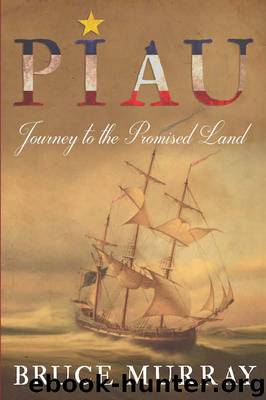Piau by Bruce Murray

Author:Bruce Murray
Language: eng
Format: epub
Publisher: Dundurn
Published: 2017-08-02T04:00:00+00:00
It was in the beginning of July 1744 that we heard the cannon fire coming from the fort. We heard repeated shots and at times we recognized distant musket fire as well. We questioned who it might be. Considering no ships had passed by us at Melanson Village, we concluded it was not the French.
Indeed, it was not the French who arrived at Annapolis Royal that day, it was the Mi’kmaq. They must have portaged through the woods from Grand Pré and canoed downriver to the fort.
By late evening we were witnessing the clear night sky illuminated by the fire of the burning town. It was so alarming we thought we could feel its heat from our village. Our entire community watched anxiously from the water’s edge. We hoped we would be spared the fate of our Acadian neighbours at Annapolis. We had always been on good terms with the Mi’kmaq, but our neutrality toward the British was a thorn in the side of that relationship.
The next day or two were relatively quiet save for a few distant gunshots. But on day three we spotted a large ship looming on the horizon of Annapolis Basin. Was it French or British? The answer to this question would have a major impact on our future. I am hesitant to admit it, but we were actually relieved to discover it was a British warship bearing the name Prince of Orange. It was trailed by another vessel carrying at least a hundred soldiers. This British ship had arrived to protect Annapolis; a French vessel would have meant the destruction of both the fort and our way of life. Despite our relief on that day, this would be the last time we supported the British in our hearts and minds.
After several days had passed, Charles and I decided to sail into Annapolis to survey the damage done by the Mi’kmaq. It was worse than we had imagined. Most of the town was in ruins. We heard from our Acadian friends that much of the damage was created by the soldiers themselves, wishing to deprive the Mi’kmaqs of a place from which to launch their attacks on the fort. The New England volunteers had even destroyed the church and the priest’s residence despite Mascarene’s orders to spare them. The church still symbolized the French regime and the support the Natives gave to the French Catholics. The New Englanders were Protestant, and destruction was the price of war.
We had heard that the lieutenant-governor promised to compensate the English subjects and merchants for their losses. The Acadians’ losses were also great, but no compensation was promised them. The principal loss to both the English and the Acadians was their livestock, destroyed by the Mi’kmaq warriors. We promised our Acadian friends that we would assist them by donating the fruits of our breeding stock so they could begin rebuilding their herds of sheep and cattle. We knew they would have done the same for us.
Download
This site does not store any files on its server. We only index and link to content provided by other sites. Please contact the content providers to delete copyright contents if any and email us, we'll remove relevant links or contents immediately.
In Control (The City Series) by Crystal Serowka(35353)
The Wolf Sea (The Oathsworn Series, Book 2) by Low Robert(33838)
We Ride Upon Sticks by Quan Barry(33272)
Crowbone (The Oathsworn Series, Book 5) by Low Robert(32314)
The Book of Dreams (Saxon Series) by Severin Tim(32225)
The Daughters of Foxcote Manor by Eve Chase(22279)
Trainspotting by Irvine Welsh(20041)
Call Me by Your Name by André Aciman(18946)
Shot Through The Heart (Supernature Book 1) by Edwin James(17920)
The Secret History by Donna Tartt(16605)
The Girl from the Opera House by Nancy Carson(14981)
Sad Girls by Lang Leav(13342)
American King (New Camelot #3) by Sierra Simone(12976)
Pimp by Iceberg Slim(12920)
All the Missing Girls by Megan Miranda(12736)
The Betrayed by Graham Heather(11688)
The Betrayed by David Hosp(11659)
4 3 2 1: A Novel by Paul Auster(11026)
Still Me by Jojo Moyes(9893)
